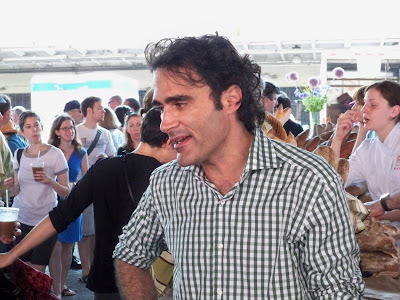
Robert LaValva nurtures a vision to establish a permanent indoor public market at the historic Fulton Fish Market in Lower Manhattan. Each season, he cultivates the idea with enthusiasm, care and resolve and watches as it begins to take root.
If the foot traffic on this sunny and warm Sunday morning at the New Amsterdam Market is an indicator, the seeds have been sown, and hordes of New Yorkers support LaValva’s dream. The vendor stalls are just beyond South Street tucked under the FDR Drive in the shadow of the Brooklyn Bridge. People are flooding the corridors between booths for this, the third meeting of the New Amsterdam Market. The seasonal event is – in effect – a dress rehearsal, aimed at building support for a permanent market to showcase artisanal products and regional, sustainable foods sourced within 500 miles of New York City.
The area just in front of the building is lined with rows of booths hosted by enterprises with delectable names – The Bent Spoon, Flying Pigs Farm, Pampered Cow, and the people’s popsicle, to name a few. As soon as I enter the market, I spot an old friend. Chef Karen Bornarth (pictured below in green), my instructor for “Classic European Breads” at the French Culinary Institute is with a colleague selling her crusty, bronze Miche – large, peasant-style whole-grain loaves. She’s enjoying the market day and the entrepreneurial atmosphere. “We don’t usually get to sell our bread at the school,” she laughs.
I manage to spend a few moments with Robert LaValva, director of the not-for-profit, New Amsterdam Public, the organization created to bring the market to fruition. Dress in a green-checked shirt and jeans, he is a tall, slender man with jet-black hair and a soft-spoken manner who is quietly passionate about his vision.
He describes the idea of regional food systems as “a real emerging movement” and tells me that recently he even met several young women who want to become butchers and are working hard to develop their upper arm strength so they can lift large cuts of beef. “It’s an amazing time of change.”
It has taken New York some time to come to grips with what LaValva calls “this civic, urban thing called a public market.” Europe has many established markets, as do several cities in the United States. LaValva sees a future that will draw on New York’s agricultural heritage and its rich history, ultimately benefiting the economy of the region.
“New York once had such a market,” he tells me, “but it was less out of philosophy, and more out of necessity,” as purveyors would gather at central locations in the city to sell their wares.
“We are standing on the site of the city’s first market, established in 1642,” LaValva says. The location along South Street was a convenient gathering place for farmers from Brooklyn and the agricultural areas that surrounded the original boundaries of the city.

While numerous Greenmarkets are well-established in New York, LaValva tells me the greenmarket structure doesn’t necessarily work for every farmer’s business model. “It’s clear there’s a need to go beyond,” he says. “If we want regional food systems, we need to find other outlets.”
I ask LaValva how long it will take before his vision is realized. He pauses. “As long as it needs to,” he smiles. “Markets take time to grow.”
©2008 T.W. Barritt All Rights Reserved













